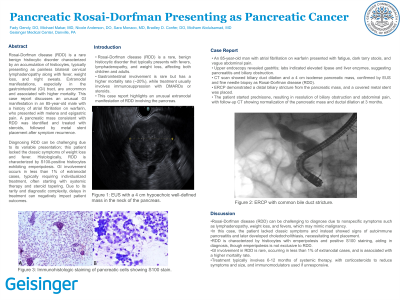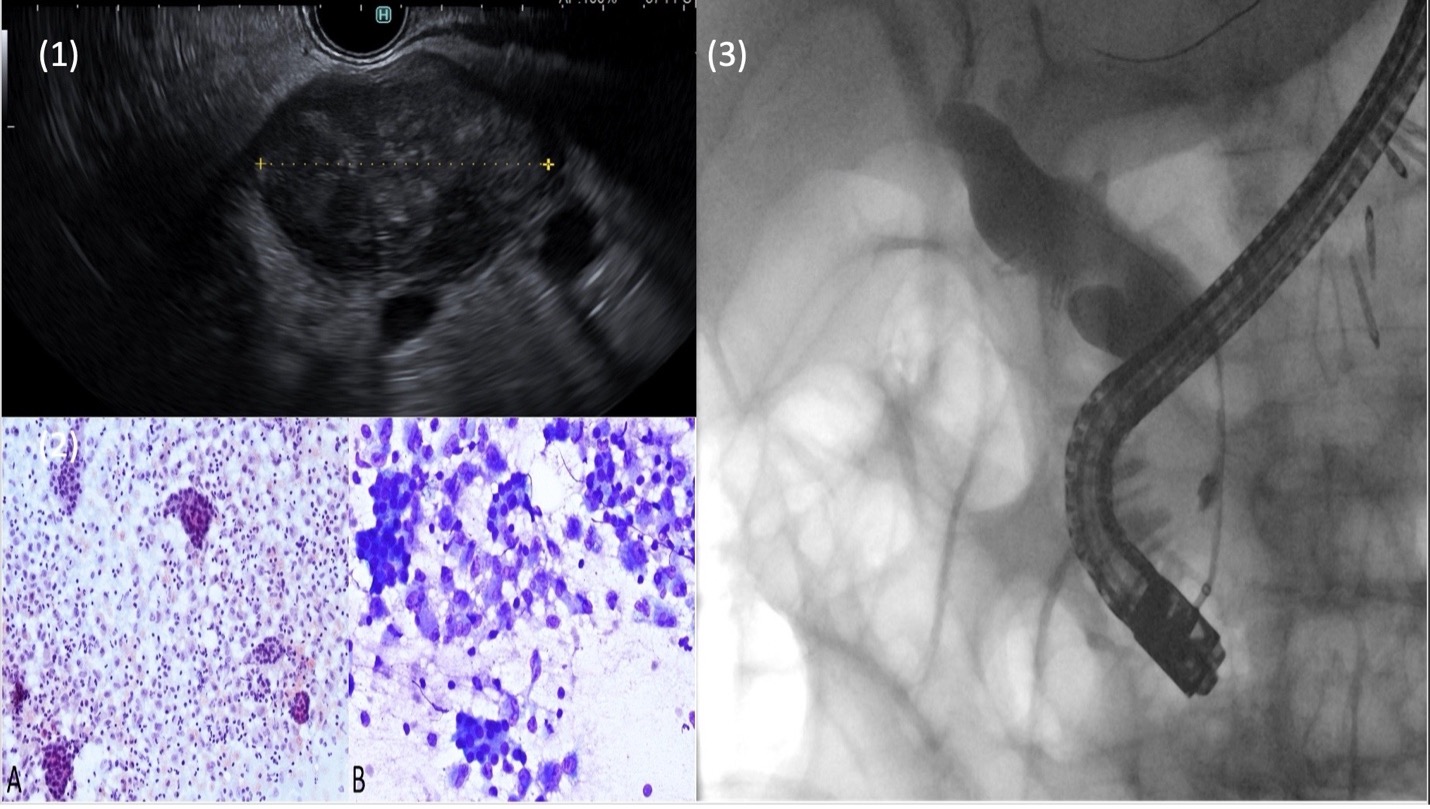Tuesday Poster Session
Category: Biliary/Pancreas
P3539 - Rosai-Dorfman Disease of the Pancreas Mimicking Pancreatic Cancer
Tuesday, October 29, 2024
10:30 AM - 4:00 PM ET
Location: Exhibit Hall E

Has Audio

Fady Gendy, DO
Geisinger Health System
Danville, PA
Presenting Author(s)
Fady Gendy, DO, Michael Makar, MD, Nicole Anderson, DO, Sara Monaco, MD, Bradley D.. Confer, DO, Molham Abdulsamad, MD
Geisinger Health System, Danville, PA
Introduction: Rosai-Dorfman disease (RDD) is a rare benign non-Langerhans histiocytic disorder described as an accumulation of histiocytes which usually presents as bilateral painless cervical lymphadenopathy with associated symptoms of fever, weight loss, and night sweats and can have extranodal manifestations. GI manifestations are generally rare but carry a 20% mortality rate. Although RDD is usually self-limited, treatment focuses typically on immunosuppressive therapies. This case report highlights a unique presentation of RDD with an extranodal GI manifestation.
Case Description/Methods: An 85-year-old man with a past medical history of atrial fibrillation on warfarin therapy presented to the emergency department with melena and complaint of epigastric pain. CT imaging and endoscopy did not show any acute findings. EUS was done which showed a 4 cm pancreatic mass (figure 1) that stained positive for S100 on histologic analysis consistent with RDD (figure 2). He was discharged from the hospital on a steroid taper and later returned with worsening symptoms with repeat CT imaging showing intrahepatic and extrahepatic biliary duct dilation, 2cm dilated common bile duct and isodense pancreatic mass. The patient underwent ERCP with metal stent placement with resolution of his symptoms (figure 3).
Discussion: RDD presents a difficult diagnostic picture given the varying spectrum of presentations. Classically, this ailment is seen with symptoms of weight loss, night sweats, and fever. This case is unique as the patient had no classic symptoms and instead presented with concerns of autoimmune hepatitis.
Histologically, RDD histiocytes exhibit emperipolesis and S100 staining. Literature on the gastrointestinal (GI) manifestations of RDD is limited, with the GI tract being involved in less than 1% of all extranodal cases and having a higher mortality rate as compared to non-GI cases. Treatment for RDD usually depends on the sequelae of the nodal or extra-nodal manifestation present. Although there are no current guidelines on treatment of RDD, a suggested approach is 6-12 months of systemic therapy followed by observation. Generally, response is assessed and a steroid taper can be started with escalation to immunomodulator therapy with TNF-alpha inhibitors such as Lenalidomide if the patient is not improving. Although usually self-limited, the difficulty of diagnosis of RDD can lead to delayed treatment.

Disclosures:
Fady Gendy, DO, Michael Makar, MD, Nicole Anderson, DO, Sara Monaco, MD, Bradley D.. Confer, DO, Molham Abdulsamad, MD. P3539 - Rosai-Dorfman Disease of the Pancreas Mimicking Pancreatic Cancer, ACG 2024 Annual Scientific Meeting Abstracts. Philadelphia, PA: American College of Gastroenterology.
Geisinger Health System, Danville, PA
Introduction: Rosai-Dorfman disease (RDD) is a rare benign non-Langerhans histiocytic disorder described as an accumulation of histiocytes which usually presents as bilateral painless cervical lymphadenopathy with associated symptoms of fever, weight loss, and night sweats and can have extranodal manifestations. GI manifestations are generally rare but carry a 20% mortality rate. Although RDD is usually self-limited, treatment focuses typically on immunosuppressive therapies. This case report highlights a unique presentation of RDD with an extranodal GI manifestation.
Case Description/Methods: An 85-year-old man with a past medical history of atrial fibrillation on warfarin therapy presented to the emergency department with melena and complaint of epigastric pain. CT imaging and endoscopy did not show any acute findings. EUS was done which showed a 4 cm pancreatic mass (figure 1) that stained positive for S100 on histologic analysis consistent with RDD (figure 2). He was discharged from the hospital on a steroid taper and later returned with worsening symptoms with repeat CT imaging showing intrahepatic and extrahepatic biliary duct dilation, 2cm dilated common bile duct and isodense pancreatic mass. The patient underwent ERCP with metal stent placement with resolution of his symptoms (figure 3).
Discussion: RDD presents a difficult diagnostic picture given the varying spectrum of presentations. Classically, this ailment is seen with symptoms of weight loss, night sweats, and fever. This case is unique as the patient had no classic symptoms and instead presented with concerns of autoimmune hepatitis.
Histologically, RDD histiocytes exhibit emperipolesis and S100 staining. Literature on the gastrointestinal (GI) manifestations of RDD is limited, with the GI tract being involved in less than 1% of all extranodal cases and having a higher mortality rate as compared to non-GI cases. Treatment for RDD usually depends on the sequelae of the nodal or extra-nodal manifestation present. Although there are no current guidelines on treatment of RDD, a suggested approach is 6-12 months of systemic therapy followed by observation. Generally, response is assessed and a steroid taper can be started with escalation to immunomodulator therapy with TNF-alpha inhibitors such as Lenalidomide if the patient is not improving. Although usually self-limited, the difficulty of diagnosis of RDD can lead to delayed treatment.

Figure: Figure 1: EUS with a 4 cm hypoechoic well-defined mass in the neck of the pancreas.
Figure 2: Direct smears from the EUS-guided FNA/FNB of the mass showed numerous histiocytes with intermixed groups of pancreatic acinar cells (A – Papanicolaou stained slide, 200X; B – Diff-Quik® stained slide, 400X).
Figure 3: ERCP with common bile duct stricture.
Figure 2: Direct smears from the EUS-guided FNA/FNB of the mass showed numerous histiocytes with intermixed groups of pancreatic acinar cells (A – Papanicolaou stained slide, 200X; B – Diff-Quik® stained slide, 400X).
Figure 3: ERCP with common bile duct stricture.
Disclosures:
Fady Gendy indicated no relevant financial relationships.
Michael Makar indicated no relevant financial relationships.
Nicole Anderson indicated no relevant financial relationships.
Sara Monaco indicated no relevant financial relationships.
Bradley Confer: Boston Scientific Corporation – Consultant. Exact Sciences – Advisory Committee/Board Member, FDA advisory panel.
Molham Abdulsamad indicated no relevant financial relationships.
Fady Gendy, DO, Michael Makar, MD, Nicole Anderson, DO, Sara Monaco, MD, Bradley D.. Confer, DO, Molham Abdulsamad, MD. P3539 - Rosai-Dorfman Disease of the Pancreas Mimicking Pancreatic Cancer, ACG 2024 Annual Scientific Meeting Abstracts. Philadelphia, PA: American College of Gastroenterology.
